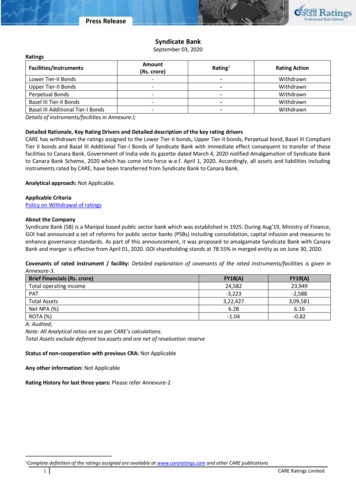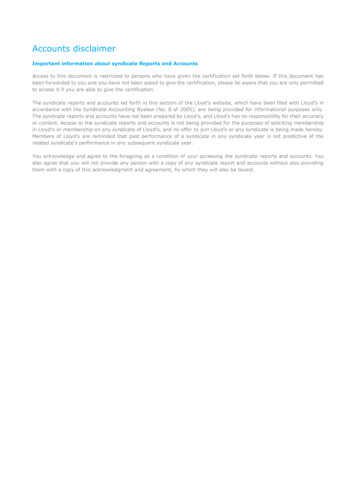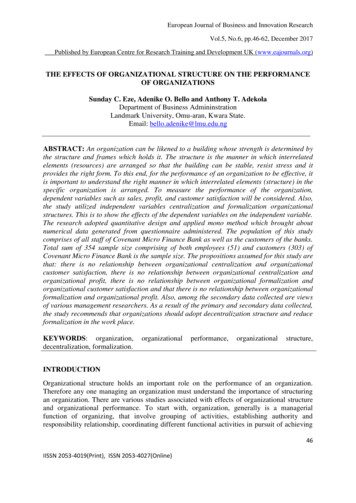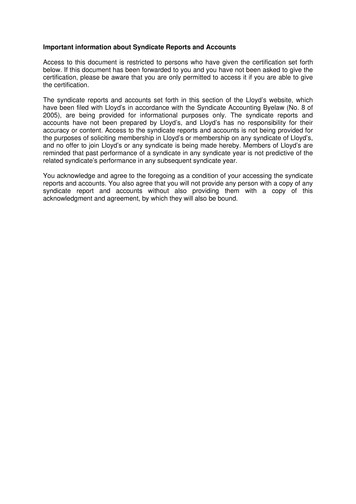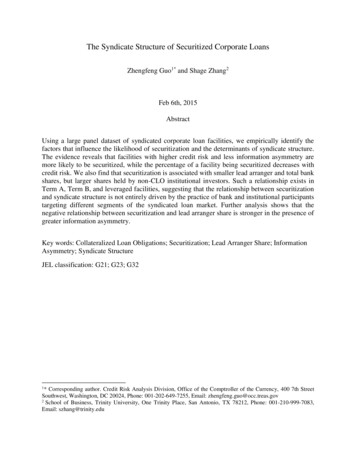
Transcription
The Syndicate Structure of Securitized Corporate LoansZhengfeng Guo1* and Shage Zhang2Feb 6th, 2015AbstractUsing a large panel dataset of syndicated corporate loan facilities, we empirically identify thefactors that influence the likelihood of securitization and the determinants of syndicate structure.The evidence reveals that facilities with higher credit risk and less information asymmetry aremore likely to be securitized, while the percentage of a facility being securitized decreases withcredit risk. We also find that securitization is associated with smaller lead arranger and total bankshares, but larger shares held by non-CLO institutional investors. Such a relationship exists inTerm A, Term B, and leveraged facilities, suggesting that the relationship between securitizationand syndicate structure is not entirely driven by the practice of bank and institutional participantstargeting different segments of the syndicated loan market. Further analysis shows that thenegative relationship between securitization and lead arranger share is stronger in the presence ofgreater information asymmetry.Key words: Collateralized Loan Obligations; Securitization; Lead Arranger Share; InformationAsymmetry; Syndicate StructureJEL classification: G21; G23; G321* Corresponding author. Credit Risk Analysis Division, Office of the Comptroller of the Currency, 400 7th StreetSouthwest, Washington, DC 20024, Phone: 001-202-649-7255, Email: zhengfeng.guo@occ.treas.gov2School of Business, Trinity University, One Trinity Place, San Antonio, TX 78212, Phone: 001-210-999-7083,Email: szhang@trinity.edu
1.IntroductionCollateralized Loan Obligations (CLOs) are structured financial products primarilybacked by syndicated loans.1 Despite a significant decrease in volume during the financial crisis,the issuance of CLOs was resurrected before long. According to S&P Capital IQ/LCD, CLOissuance in the U.S. in April 2014 hit 11.8 billion. In the wake of a large CLO market, financeresearchers including Bord and Santos (2011), Shivdashani and Wang (2011), Benmelech et al.(2012), Wang and Xia (2014), and others, have recently sought to better understand the influenceof CLO market on syndicated corporate loans by analyzing the effects of securitization on leadbank incentives, syndicated loan performance, and the cost of borrowing.In this paper, we examine the syndicate structure of securitized corporate loans. Thesyndicate structure plays an important role in determining loan yields (Ivashina, 2009), allowinglending banks to credibly commit to loans they originate, and leveraging bank’s privateinformation to the benefit of borrowing firms (Narayanan et al., 2004). Thus, our study offersanother important dimension to better understand the role of securitization. With our rich dataset,we are able to clearly identify a large sample of securitized loan facilities and observe theirsyndicate structure over time. This allows us to address the following questions: (1) what are thefactors that influence the likelihood of a loan facility being securitized? (2) Upon a decision ofsecuritization, what proportion of the loan facility in question will be securitized? (3) How doessecuritization affect the syndicate structure and shares held by different parties, such as the leadarranger, bank participants and institutional participants?1A syndicated loan facility is considered as securitized if a fraction of the loan facility is sold to CLO entities thatissue CLOs using loans as collaterals.
Our main results indicate that a facility is more likely to be securitized as the facilityamount and maturity increase, as information about the borrower becomes more transparent, asthe borrower becomes larger, and as the facility’s observable risk measured by credit andperformance ratings increase. Consistent with the argument that the pursuit of riskier loans is toseek high returns to suffice CLO manager’s financing cost (Benmelech and Dlugosz, 2009), ourfinding suggests that CLO entities have a strong preference towards investing in riskier but moretransparent loan facilities.We document that the total percentage share held aggregately by all CLO entities in afacility (termed as percentage of securitization) varies a lot among securitized facilities. Ouranalysis reveals that although credit risk increases the likelihood of securitization, it is negativelyassociated with the percentage of securitization in a loan facility. Less information asymmetry,on the other hand, is associated with higher percentage of securitization. The percentage ofsecuritization is significantly higher if the borrower is a public firm with more transparentfinancial information available, and if the lead arranger is extending a credit to a distant borrowerwho presumably has a less severe asymmetric information problem (Petersen and Rajan, 2002).Consistent with Bord and Santos (2012), we find that both lead arranger share and totalbank share are significantly smaller in securitized loan facilities. In contrast, the aggregate shareheld by all non-CLO institutional investors (such as hedge fund, private equity fund, mutual fund,insurance companies and financial companies) is much larger in securitized loan facilities. Theaverage difference in lead arranger share and the aggregate share by all non-CLO institutionalinvestors between securitized and non-securitized facilities are around -9 to -11 percentagepoints and 17 to 19 percentage points, respectively, after controlling for facility, borrower andlead arranger characteristics.1
One potential explanation of lower lead arranger and total bank shares is that institutionalinvestors crowd out the fund contributed by the lead arranger and other bank participants, giventhe observation that institutional investors often invest in Term B facilities and securitization alsooccurs more often among Term B facilities. We investigate this possibility by looking atsubsamples of Term A and Term B facilities separately. The evidence reveals that securitizationis associated with lower lead arranger and total bank shares in both subgroups and the magnitudeis slightly larger among Term B facilities. Moreover, we include the number of institutionalparticipants (including both CLO and non-CLO institutions) in a syndicate to explicitly controlthe demand effect from institutional investors. We still find both lead arranger and total bankshares to be considerably smaller in securitized facilities. These results suggest that institutionaldemand can’t fully explain the lower lead arranger and total bank shares in securitized facilities.In other words, having CLO entities in a syndicate has a distinct impact on the bank sharesbeyond the number of institutional investors involved.Because the majority of securitized facilities are issued by borrowers with speculativegrade credit ratings, the capital regulations of bank participants can also result in lower bankshares in securitized facilities. To explore this possibility, we look at the subsample of leveragedloan facilities. We find that both lead arrangers and bank participants can hold large proportionsof speculative loan facilities, and even the entire facilities in some cases. The lead arranger shareranges from 0% to 57% and the total bank share ranges from 0% to 100% among leveraged loanfacilities. Moreover, securitization is again associated with lower lead arranger and bank sharesin this subsample, suggesting that our results are not entirely due to bank regulations.Finally, lower lead arranger and bank shares can be indicative of a potential adverseselection problem. Theory suggests that lead arrangers’ exposure to loans they originate induces2
proper ex ante screening and ex post monitoring effort; hence, it is an important mechanism toreduce asymmetric information between the borrower and outside lenders (Holmstrom andTirole, 1997). Securitization can change such incentives because originating banks can sell offthe loans to CLO entities that have a high demand for loans in order to underwrite CLOs. Theincentive of securitization can be stronger when the lead arranger possesses negative privateinformation on the quality of the loan, leading to a more severe adverse selection issue. Ourfinding that a lead arranger holds an even smaller proportion of a securitized facility when theissuer is a private company or when a public issuer lacks a credit rating suggests a potentialadverse selection problem.We find non-CLO institutional investors play a unique role in the syndicated loan marketby supplying capital to risky loans. While lead arranger, bank participants and even CLOparticipants tend to hold significantly lower shares in risky facilities, non-CLO institutions investsignificantly more in these facilities, and their share increases with a facility’s credit risk.Our paper contributes to the extant literature in many important aspects. First of all, thispaper adds to the literature that examines syndicate structure (e.g. Dennis and Mullineaux, 2000;Lee and Mullineaux, 2004; Jones et al., 2005; Sufi, 2007). To the best of our knowledge, ourstudy is the first to study the syndicate structure of securitized corporate loans. Relying on therichness of our dataset, we not only identify the factors that influence the likelihood ofsecuritization, but also explore the determinants of the percentage of securitization in a facility,given such a large variation of this percentage among securitized loan facilities.Moreover, the panel structure of the data allows us to track each facility from originationto several years afterwards. Compared to most of the existing studies with only cross-sectional3
data at loan origination, our analysis is conducted in a panel structure, exploring both crosssectional and over-time variations in riskiness, information asymmetries, the decision ofsecuritization and changes in syndicate structure.Lastly, by linking the Shared National Credit (SNC) program data with Computat, ourdata on securitized facilities is much more comprehensive than most of the existing studies. Weare able to clearly identify a much larger sample of securitized term loans with 4,199 facilities(7,841 facility-year observations) originated during the long period between 1999-2010,compared to 302 securitized facilities in Benmelech et al. (2012) and 331 in Nadauld andWeisbach (2012). Bord and Santos (2014) use the same database and approach to identifysecuritized facilities with a focus on a shorter period of 2004-2008.The rest of the paper is organized as follows. In section 2, we detail our sampleconstruction and provide some relevant summary statistics. Section 3 presents our analysis of thedecision of securitization and the percentage of securitization. Section 4 presents our results onthe relationship between securitization and syndicate structure. Section 5 concludes our study.2. Data Construction and Summary Statistics2.1 Data source and identification of securitized loan facilitiesOur loan information is obtained from Shared National Credit (SNC) program run by theFederal Deposit Insurance Corporation (FDIC), the Federal Reserve Board, and the Office of theComptroller of the Currency (OCC). CLO entities almost always have a preference of term loans4
over revolving credit lines;2 hence we only keep term loan facilities which are then grouped intoTerm A facilities (usually is amortized) and Term B facilities (usually is “bullet”). 3For each loan facility that exceeds 20 million and is jointly held by three or morefederally supervised institutions, the following information is collected and updated at the end ofevery year: the identity of the borrower, type of credit (i.e., Term A or Term B), purpose of theloan (i.e., merger and acquisition, business recapitalization/dividends, project finance and so on),principal amount, maturity date, credit rating, names of the lead arranger and syndicateparticipants, and shares held by the lead arranger and each participant.4 We have panel data on14,370 unique facilities with 29,478 facility-year observations. The borrowers’ firm levelinformation is obtained from Compustat and then merged to our sample by matching borrowernames in SNC with company names in Compustat.We identify loan facilities sold to CLO entities either at origination or later on by filteringthe syndicate participants’ names. We identify 1,579 unique CLO entities if the participant’sname contains “CLO” or “CDO” letters. We then get a list of CLO entities from CLO databankat structuredcreditinvestor.com (SCI) as well as Moody’s CDO deal library. By doing so, we areable to obtain additional 458 unique CLO entities. We then compare the list of these entities tothe syndicate participants’ names to identity which participants are CLO entities. We consider2See Benmelech and Dlugosz (2009), Benmelech et al. (2012), Nadauld and Weisbach (2012), and Wang and Xia(2014).3Following Lim et al. (2014), we treat facilities with B or higher designation letters (e.g., C, D, and etc.) as Term Bfacilities, and treat term loan facilities without letter designation as Term B facilities as well.4We have more Term A facilities than Term B facilities in the sample. This is mainly due to the large proportion ofTerm A facilities during the 1999-2005 period. The representation of Term B facilities in SNC increases after 2005,and they make up about 60% of all facilities in our sample after 2006. In robustness, we conduct all our tests usingonly the sub sample period during 2006-2010, and all results stay qualitatively the same. The results are availableupon request.5
facilities with at least one CLO participant as being securitized. The rest are classified as nonsecuritized facilities.Securitization occurs rather frequently. Out of our 14,370 loan facilities originated during1999-2010, 4,199 facilities (about 29%) are securitized either at origination or later on.Securitization occurs around 38% of the time in the Term B facilities that institutional investorsoften target (Nandy and Shao, 2010), and about 27% of the time in Term A facilities that areoften considered bank facilities.5 Moreover, securitization can occur for both leveraged loansand loans with investment grade ratings, although it primarily concentrates on leveraged loans.Our data suggest that about 30% of the leveraged facilities are securitized, compared to 14% ofinvestment grade loan facilities. Once a facility is securitized, the proportion sold to CLOentities can vary a lot. The percentage of credit being sold to CLO entities ranges from 0.59% to68.82%, among all securitized facilities in our sample.2.2 Loan characteristicsOur sample has 4,199 unique CLO facilities (with 7,841 facility-year observations) from1999 to 2010, 84% of these facilities are sold to CLO entities at origination and the rest aresecuritized afterwards. The 4,199 CLO facilities are issued by 2,055 unique borrowers, and weare able to match 715 of them to Compustat companies. In comparison, there are 10,817 nonCLO facilities (with 21,637 facility-year observations) during the sample period. These facilitiesare issued by 6,508 unique borrowers, and we are able to match 1,351 of them to Compustatfirms.5This is different from studies on loan securitization that exclude Term A facilities, such as Benmelech et al. (2012),and Wang and Xia (2014).6
Table 1 compares the characteristics of securitized and non-securitized facilities. Theaverage size of securitized facility is 2.6 times larger than the average non-securitized one. Theaverage maturity of securitized facility is also 0.54 year longer. The average lead arranger sharein securitized facilities is 4.70%, considerably smaller than the 24.28% of non-securitizedfacilities.Securitized Term B facilities are slightly larger and of longer maturity than securitizedTerm A facilities. Both lead arranger share and total bank share are larger in securitized Term Afacilities than securitized Term B facilities. The percentage of securitization is higher in Term Bfacilities once a facility is securitized.Following Nadauld and Weisbach (2012) and Wang and Xia (2014), we define leveragedloan facilities as those issued by borrowers with ratings below BBB- as well as non-ratedborrowers. About 98% of securitized facilities are leveraged facilities, and the percentage ofsecuritization is larger for leveraged loan facilities than that of the investment grade facilitiesonce securitized.2.3. Borrower characteristics and statistics on syndicate participantsTable 2A reports borrower characteristics. 34.79% of securitized facilities are issued topublic borrowers, compared to 20.76% of non-securitized facilities. On average, securitizedfacilities are issued by companies with larger total assets. The average Altman’s Z-score forsecuritized facility borrowers is lower than non-securitized facility borrowers, suggesting thatborrowers of securitized facilities are more likely to be in financial distress. The averagedistance between the borrower and the lead arranger is slightly longer for securitized facilitiesthan non-securitized ones. There is no significant difference in stock volatility of borrowers7
across the two groups. However, their credit rating distributions are quite different. 36.08% ofthe securitized credit borrowers do not have S&P long-term debt ratings, while a much higher54.16% of non-securitized credit borrowers do not have S&P long-term debt ratings. Securitizedfacilities tend to concentrate on borrowers with BB ratings (including BB, BB and BB -) and Bratings (including B, B , B-), only about 4.43% of the securitized facility borrowers haveinvestment grade ratings (BBB- or above). On the other hand, 16.58 % of the non-securitizedcredit borrowers are rated as investment grade.Table 2B shows that the number of lead arrangers per year over the sample period staysrelatively stable. It is noteworthy that the number of syndicated loans held by these banks isconcentrated in the top 10 largest banks, who jointly underwrite more than 50% of the loans. Onthe other hand, the number of unique participants, especially CLO entities is increasing rapidlyover years. The number of CLO entities is only 38 in year 1999 and it dramatically increases to1,756 entities by the year 2010. The average number of participants in a syndicate loan facilityalso increases significantly from about 21 participants in 1999 to about 232 participants in 2010.The average number of participants in securitized facilities is even larger than the sampleaverage each year. By 2010, the average securitized facility has about 254 participants.2.4 Key variables in the empirical estimationSyndicate structure. We examine the syndicate structure by first looking at the leadarranger share, which is measured by the dollar amount of capital contributed by the leadarranger over the total proceeds of this loan facility. The second dimension we look at is totalbank share, which is the aggregate dollar amount of capital contributed by all bank participants8
as a percentage of the total loan facility proceeds.6 For securitized facilities, we also examine thepercentage of securitization, calculated as the percentage of capital contributed by all CLOparticipants over the total facility proceeds. We then examine the non-CLO institutional shares,calculated as the aggregate dollar amount of capital contributed by all non-CLO institutionalinvestors over total proceeds of the loan facility. Using our panel data structure, we are able toobserve both cross-sectional and time-series changes in these variables.Credit risk. Our first measure is the credit quality evaluation compiled by regulatoryauthorities and reported in the SNC database. Bank regulators review a certain percentage ofSNC loans annually, whereas the rest of the loans are either unrated or assigned the same riskrating used by the lead arranger. The credit quality of each facility is assessed. Each facility canhave multiple ratings, where each rating is assigned to a portion of the total exposure. Facilitieswith no perceived credit problems are rated “Pass”; facilities with a minor weakness are rated“Special”; the remaining facilities are rated as “Substandard”, “Doubtful” or “Loss” withincreasing likelihood of bank sustaining a loss. In this paper, we use the proportion of a facilityassigned non-Pass ratings (including “Substandard”, “Doubtful” and “ Loss”) to measure creditrisk, since facilities falling into these categories are more likely to default.The second set of credit risk measures is the borrowers’ long-term debt credit ratingsassigned by S&P. We group S&P ratings into five categories. Category “A” includes S&Pratings of AAA, AA , AA, AA-, A , A, and A-. Category “BBB” includes S&P ratings ofBBB , BBB, and BBB-. Category “BB” includes BB , BB, and BB-). Category “B” includesB , B, and B-. Category “Other” includes S&P ratings of CCC , CCC, CCC-, CC, and D.6The bank participants are defined by the lender type variable in SNC database.9
Information transparency/opaqueness. We use several variables to capture the degree ofinformation asymmetry in a facility. First of all, required SEC filing for public firms significantlyreduces the information asymmetry between the borrower and outside financers, compared toprivate firms (Sufi, 2007). Credit ratings provided by rating agencies contain valuableinformation and hence are an important mechanism to reduce information friction (Bosch andSteffen, 2011). Therefore, we view public borrowers with an S&P debt rating to be moretransparent than those without such a rating. Second, a lead arranger can learn a significantamount of information about the borrower from repeated interactions over time, reducing theinformation asymmetry between the borrower and the bank (Boot, 2000). Moreover, theexistence of a prior relationship between the borrower and the lead arranger also exposes moreinformation to other participants in the syndicate. The third proxy of information asymmetry isthe geographic distance between a borrower and its lead arranger. Petersen and Rajan (2002)argue that borrowers with good credit quality and more transparency can borrow from a distantlender, whereas more opaque companies with low quality rely more heavily on local lenders whocan take advantage of collecting borrower information due to close proximity; thus, thegeographic distance between the borrower and its lead arranger can be inversely related to thedegree of information asymmetry. Lastly, Aboody and Lev (2000) find that firms with R&Dinvestments can have higher information asymmetry. Following their approach, we construct anR&D firm indicator variable for firms that have reported R&D expenditures during our sampleperiod.3. The Decision of Securitization10
This section presents two analyses: (1) what factors are related to the likelihood of certainfacilities being securitized? (2) Upon securitization, what factors are related to the percentage ofa facility being securitized?Given that a large number of facilities are not securitized, factors explaining thelikelihood of securitization may not be the same or have similar effects as those affecting thepercentage of securitization. Following Ramalho and Silva (2009) and Papke and Wooldridge(1996), we use a two-part fraction model to estimate these two separate analyses. The first part isa probit model estimating the securitization likelihood using the full sample, while the secondpart is a generalized linear model estimating the percentage of securitization in the subsample ofsecuritized facilities.Table 3 reports the estimation of the likelihood of being securitized. The dependentvariable equals one if there is a CLO entity participating in the facility for that year. Because ofthe panel structure, we are able to estimate the likelihood of securitization at any given yearduring the life of a loan facility. To control for potential industry and overall economic-wideshocks, all estimations include borrower industry, year, and lead arranger fixed effects.From our regression results, large loan facilities with longer maturities are much morelikely to be securitized. Loan type also matters. Term A facilities are significantly less likely tobe securitized than term B facilities, perhaps because CLO entities prefer bullet payment in orderto match the cash flows of the CLOs they underwrite. The identity of lead arrangers also has animpact on the process of securitization. Securitization-active lead arrangers are associated with ahigher likelihood of securitization.11
Riskier facilities are more likely to be securitized. For example, a higher proportion of thefacility being assigned non-Pass ratings is associated with a higher likelihood of beingsecuritized. Higher S&P credit ratings also lead to higher likelihoods of securitization. Theseresults are consistent with the notion that CLO managers strategically invest in collaterals toachieve certain ratings and provide sufficient returns for their investors. Indeed, Benmelech andDlugosz (2009) document that the majority of the CLOs have collateral pools with a weightedaverage credit rating of B or BB.More importantly, we find that transparent loan facilities are much more likely to besecuritized than opaque facilities that potentially have greater information asymmetry problems.For instance, public firm borrowers are associated with a much higher likelihood ofsecuritization; on the other hand, non-rated borrowers are associated with a lower likelihood ofsecuritization. Well established prior lending relationships between the borrower and the leadarranger also increase the likelihood of securitization. The geographic distance between the leadarranger and the borrower is positively associated with the chance of securitization. Moreover, ifthe company was a securitized facility borrower in the past, its new loan is also more likely to besecuritized. One potential explanation of these findings is that CLO entities tend to avoid opaquefacilities to minimize potential adverse selection issue, due to their very limited access toborrower information compared to the lead arrangers and other bank participants.We then estimate the percentage of securitization conditional on a facility beingsecuritized. According to Benmelech and Dlugosz (2009), most CLOs have restrictions on thelevel of concentration in loans from a single issuer, which is typically around 2%. Byconstruction, the credit share held by any single CLO participant is very small; therefore,examining the aggregate percentage share of all CLO participants in a syndicate can reveal more12
information on the process of securitization. Interestingly, we find that although higher riskleads to a higher chance of being securitized, it does not necessarily lead to higher percentage ofsecuritization. On the contrary, we find that the percentage of securitization decreases with theproportion of the facility assigned non-Pass ratings and increases with the borrower’s Altman Zscore. Moreover, although securitization tends to occur more often among speculative loanfacilities, better rated facilities attract significantly more CLO participants and thus have higherpercentage of securitization.The percentage of securitization is higher in less opaque facilities. We find that bothpublic borrowers and distant borrowers, two measures indicating less asymmetric information,are positively and significantly associated with the percentage of securitization. This againsuggests that CLO entities tend to prefer more transparent facilities due to their disadvantages ingetting access to borrower information.Consistent with the argument that lead arrangers need to solicit more heavily frominstitutional investors when bank capital is not sufficient to fill up the facility (Ivashina and Sun,2011; Lim et al, 2014), we find that Term A facilities have a significantly smaller percentage ofsecuritization, conditional on a facility being securitized. Moreover, the number of bankparticipants in a syndicate is also negatively and significantly related to both the likelihood ofsecuritization and the percentage of securitization. Our finding that the percentage ofsecuritization is significantly higher if the facility is securitized at loan origination is alsoconsistent with such a syndication process.4. Securitization and the Syndicate Structure13
4.1 Baseline analysisTable 5 presents the analysis on the relationship between securitization and lead arrangershare as well as the relationship between securitization and total bank share. We includevariables capturing important characteristics of loan facilities and borrowing firms, as well asfixed effects of year, borrower industry, lead arranger and loan purpose in the regressions. Thesecuritization indicator is always negative and significant, suggesting that both lead arrangershare and total bank share are significantly lower in securitized facilities than non-securitizedones. We run additional regressions in the subgroup of Term A facilities with the majority ofparticipants being banks, and in the subgroup of Term B facilities with many non-bankparticipants. Results are reported in Table 6. Securitized facilities have significantly lower leadarranger and total bank shares in both subgroups, and the marginal effect is slightly higher inTerm B subgroup. Explicit controlling for the number of institutional participants (including bothCLO and non-CLO institutions) does not change the results.This suggests that even ininstitutional investor-dominated credit facilities, CLO entities’ subscription in a syndicate has aunique impact on the structure of the syndicate, and the effect can’t be simply explained by thecoincidence of having many institutional investors participating in the syndicates.Other notable results are as follows: (1) both lead arranger and other bank participantstend to hold smaller shares in facilities with longer maturity, and in fa
In other words, having CLO entities in a syndicate has a distinct impact on the bank shares beyond the number of institutional investors involved. Because the majority of securitized facilities are issued by borrowers with speculative-grade credit ratings, the capital regulations of bank participants can also result in lower bank



